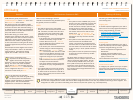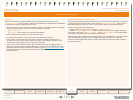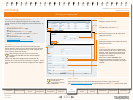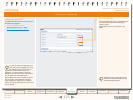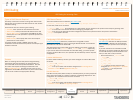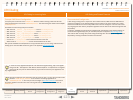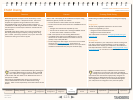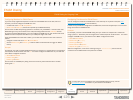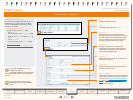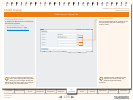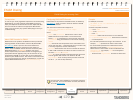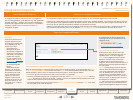
125
D14049.04
JULY 2008
Grey Headline (continued)
TANDBERG VIDEO COMMUNICATIONS SERVER
ADMINISTRATOR GUIDE
Introduction Getting Started
Overview and
Status
System
Conguration
VCS
Conguration
Zones and
Neighbors
Call
Processing
Bandwidth
Control
Firewall
Traversal
Appendices
Applications Maintenance
ENUM Dialing
Prerequisites
In order for a local endpoint to be able to dial another endpoint
using ENUM via your VCS, the following three conditions must
be met:
There must be a NAPTR record available in DNS that maps 1.
the called endpoint’s E.164 number to its URI. It is the
responsibility of the administrator of the enterprise to which
the called endpoint belongs to provide this record, and they
will only make it available if they wish the endpoints in their
enterprise to be contactable via ENUM dialing.
You must 2. congure an ENUM zone on your local VCS. This
ENUM zone must have a DNS Sufx that is the same as the
domain where the NAPTR record for the called endpoint is
held.
You must 3. congure your local VCS with the address of at least
one DNS server that it can query for the NAPTR record (and if
necessary any resulting URI).
Once the ENUM process has returned one or more URIs, a new
search will begin for each of these URIs in accordance with the
URI dialing process. If the URIs belong to locally registered
endpoints, no further conguration is required. However, if one
or more of the URIs are not locally registered, you may also
need to congure a DNS zone if they are to be located via a DNS
lookup.
Process
Below is the process that is followed when an ENUM (E.164)
number is dialed from an endpoint registered with your VCS:
The user dials the E.164 number from their endpoint.1.
The VCS initiates a search for the E.164 number as dialed. It 2.
follows the usual alias search process.
After applying any pre-search transforms, the VCS will check 3.
all its zones (local and external) and to see if any of them are
congured with either:
an
•
AlwaysMatch, or
a
•
PatternMatch with pattern that matches the E.164
number.
These zones will then be queried in priority order.
If one or more of the zones that contain a match is a neighbor 4.
zone, the neighbor will be queried for the E.164 number. If
the neighbor supports ENUM dialing, it may route the call
itself.
If one or more of the zones that contain a match is an 5.
ENUM zone, this will trigger the VCS to attempt to locate
the endpoint through ENUM. As and when each ENUM
zone congured on the VCS is queried, the E.164 number is
transformed into an ENUM domain as follows:
the digits are reversed and separated by a dota.
the b. DNS Sufx congured for that ENUM zone is appended.
DNS is then queried for the resulting ENUM domain.6.
If the DNS server nds at that ENUM domain a NAPTR record 7.
that matches the transformed E.164 number (i.e., after it
has been reversed and separated by a dot), it returns the
associated URI to the VCS.
The VCS then initiates a new search for that URI (maintaining 8.
the existing hop count). The VCS starts at the beginning of
the search process (i.e. applying any pre-search transforms,
then searching local and external zones in priority order).
From this point, as it is now searching for a SIP/H.323 URI,
the process for URI Dialing is followed.
ENUM Dialing for Outgoing Calls
Example
In this example, we wish to call Fred at Example Corp. Fred’s
endpoint is actually registered with the URI fred@example.com,
but to make it easier to contact him his system administrator
has congured a DNS NAPTR record mapping this alias to his
E.164 number: +44123456789.
We know that the NAPTR record for example.com uses the DNS
domain of e164.arpa.
We create an ENUM zone on our local VCS with a 1. DNS sufx
of e164.arpa.
We congure this zone with a pattern match mode of 2.
AlwaysMatch, so that ENUM will always be queried regardless
of the format of the alias being searched for.
We dial 3. 44123456789 from our endpoint.
The VCS initiates a search for a registration of 4. 44 118 123
456. Because the ENUM zone we have congured has a
match mode of AlwaysMatch, it is queried at the same time
as any other zones with a matching priority.
Because the zone being queried is an ENUM zone, the VCS is 5.
automatically triggered to transform the number into an ENUM
domain as follows:
the digits are reversed and separated by a dot: a.
9.8.7.6.5.4.3.2.1.4.4
the b. DNS Sufx congured for this ENUM zone, e164.arpa,
is appended.
This results in a transformed domain of
9.8.7.6.5.4.3.2.1.4.4.e164.arpa.
DNS is then queried for that ENUM domain.6.
The DNS server nds the domain and returns the information 7.
in the associated NAPTR record. This tells the VCS that the
E.164 number we have dialed is mapped to the SIP URI of
fred@example.com.
The VCS then starts another search, this time for 8.
fred@example.com. From this point the process for URI
Dialing is followed, and results in the call being forwarded to
Fred’s endpoint.




